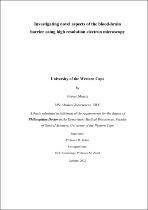| dc.contributor.advisor | Fisher, David | |
| dc.contributor.author | Mentor, Shireen | |
| dc.date.accessioned | 2022-08-10T09:19:34Z | |
| dc.date.available | 2022-08-10T09:19:34Z | |
| dc.date.issued | 2022 | |
| dc.identifier.uri | http://hdl.handle.net/11394/9222 | |
| dc.description | Philosophiae Doctor - PhD | en_US |
| dc.description.abstract | The blood-brain barrier (BBB) is a restrictive interface located between the blood
circulation and the central nervous system (CNS), regulating the homeostatic
environment of the neuronal milieu, by controlling the permeability of the
cerebrovasculature. Currently, we cannot fully comprehend the regulatory features
and the complexity of BBB morphology to allow for intervention clinically. The
thesis consists of four publications. The methodology paper proposes a novel
experimental design to visualize the morphological architecture of immortalized
mouse brain endothelial cell lines (bEnd3/bEnd5). The brain endothelial cells
(BECs) were grown on cellulose matrices and fixed in 2.5 % glutaraldehyde in
preparation for visualization of the paracellular (PC) spaces between adjacent
BECs, employing high-resolution electron microscopy (HREM), with vested
interest in the morphological profile of the developing BEC. | en_US |
| dc.language.iso | en | en_US |
| dc.publisher | University of the Western Cape | en_US |
| dc.subject | Blood-brain barrier | en_US |
| dc.subject | Brain endothelium | en_US |
| dc.subject | Electron microscopy | en_US |
| dc.subject | Nanovesicles | en_US |
| dc.subject | Nanotubes | en_US |
| dc.title | Investigating novel aspects of the blood-brain barrier using high resolution electron microscopy | en_US |
| dc.rights.holder | University of the Western Cape | en_US |

